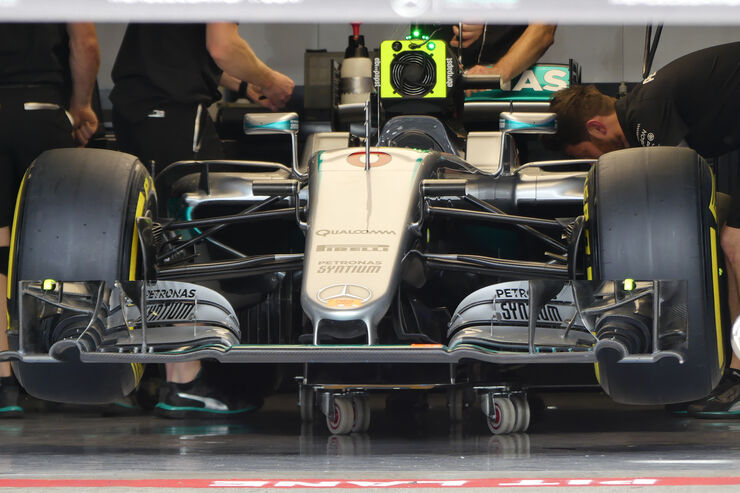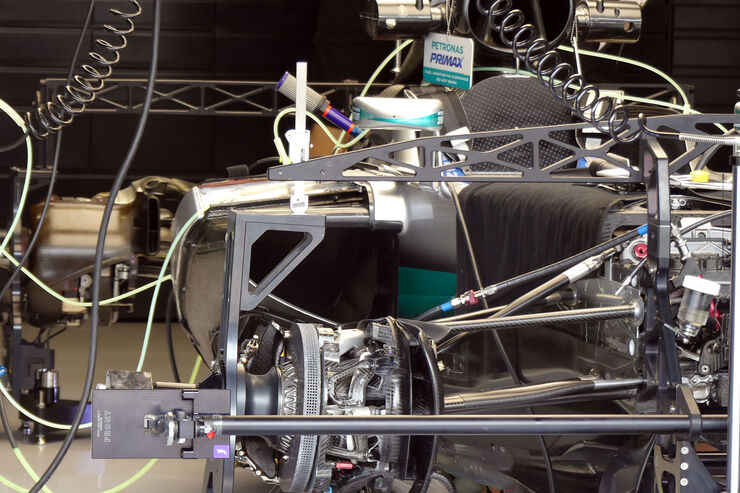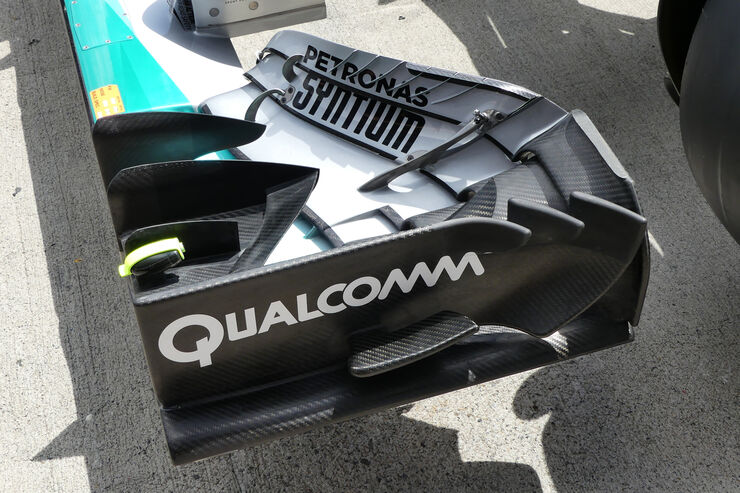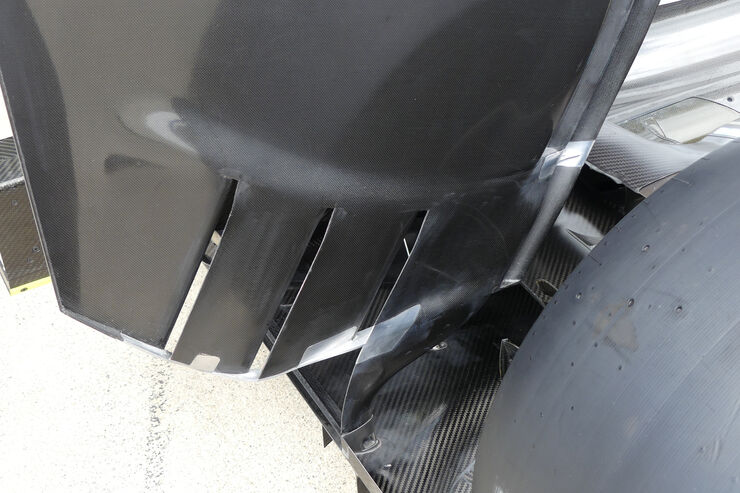- Login or Register
No account yet? Sign up
Of course the heat doesn't go from rubber, to rim to brake. But the "old" way of warming brakes, hard braking, takes quite a bit of life out of the tire, therefore, you use the tire to warmup the brakes....basti313 wrote:No, just no.Jolle wrote:What if, because Mercedes and all the other "drum brake heat teams" have better tire wear because they don't have to heat the brakes trough the tires on track? The extra energy to get them on operating temperature has to come from friction with the road. It's just a case of added energy that doesn't have to come out of the car or tires.Nickel wrote:
The tire would never get to 200 to be fair.
Either way, RB are clearly doing it and not running afoul of any rules. My question is, why is the Mercedes way, without wheel and tire mounted, better?
That's what the amus article would have us believe.
And yes, when you have your brakes on operating temp on the grid, it's better for your heated tires, but only because if you still have cold brakes, it'll cool them down.
The brake is heating the tire, not the tire heating the brake. The operating temp of the brakes is maintained by breaking, nothing else.
Preheating axle/brake does not have anything to do with the operation of the brakes. In the past (before the tire pressure limit) no one was heating the brakes on the grid, they were sometimes warmed in the garage and then during the introduction lap just by breaking.
Yes, the heat transfer is low while the car is not moving, so not much danger to overheat the tire with the heated axle. I think it is more an attempt to get the rim hot. This should be easily achievable just because of the low heat capacity of the rim and the high heat capacity of the rubber. Like this the air temperature in the tire will slightly go up and raise the pressure.e30ernest wrote:Maybe I missed the obvious, but if you are heating your brakes/axle to 200C with the aim of keeping your tires at 120C for longer, wouldn't you risk hitting and exceeding that 120C limit? Or are you just slowing down the cooldown times so that it is cooler but closer to 120C? If you are all limited at 120C, how can the "axle-warmer club" get a tire pressure advantage?


I think AMUS is on the wrong path and the pictures are misleading. The display on the Merc pictures clearly show 200°C. So the Leister Hotwind System is in temperature control mode, the red knob setting is not crucial.Nickel wrote:There's a clear picture of red bull using the same device as Mercedes with a screw through the adjustment knob, which is cranked over to max like the merc version. The screen is blacked out but the knob is clearly set to the same position.
They haven't been penalized for exceeding the warm up temps. It thus stands to reason that the hub assembly of both cars is being heated to whatever temp by air at 200C.
If you look at the rim pictures, you can see the holes in the rim. They say it is just for weight, but I do not believe this. This is a custom rim design, which is made on purpose. So I think you are on the right way: Heat up the rim inner part and have a "shield" inside the rim to protect the tire from too much heat. Like this the air temperature between rim inner part and shield can be higher than the tire temp. With heating the axle to 200°C this inner temperature is boosted just for the 5 minutes before the start, right when the tire is mounted and the pressure is measured by the FIA.Nickel wrote: The question then is why would you not want to soak the heat into the rim instead of just the hub?
Assume the carcass temp doesn't exceed 120C, why not dump heat into the rim?
Could it be because you want it to cool faster to achieve lower pressure by the time the lights turn out? Only keep the pressures up just as long as necessary?
Youre not missing anything . What Amus and others are saying is thatMercedes has invested the most into this method with Red bull second and Ferrari not so much.Nickel wrote:While red bull do it with the wheel and tire fitted. To me, this would seem the most logical way as the wheel and tire can soak up all the heat as well.
What would be the advantage of heating the hub assembly but not the wheel and tire?
The regs seem to state that the heat blankets can only go to 110 degrees, and this only for one hour. Surely hearing the rim with 200 degree air from the inside would be beneficial to the process? What am I missing?
Yes. The qestion is, why they are not putting an end to this immediately. FIA could forbid this axle heating because of safety reasons without any problems for the next race.giantfan10 wrote: Pirelli and the Fia monitoring tire pressures via sensors on a continuous basis in the near future will make this all useless anyway
Because there is nothing in the rules that deem it illegal to heat your axles would be my guess. The tires are at the Correct PSI when tested. Kind of like wings that pass the deflection test but still obviously flex under load at speed.basti313 wrote:Yes. The qestion is, why they are not putting an end to this immediately. FIA could forbid this axle heating because of safety reasons without any problems for the next race.giantfan10 wrote: Pirelli and the Fia monitoring tire pressures via sensors on a continuous basis in the near future will make this all useless anyway
No, I do not think it is like this: Pirelli and the FIA introduced mandatory camber and pressure settings out of nothing, just because of security reasons. Now teams try to play with these security limits, so FIA can easily forbid these toys just because of the very same security reasons.giantfan10 wrote:Because there is nothing in the rules that deem it illegal to heat your axles would be my guess. The tires are at the Correct PSI when tested. Kind of like wings that pass the deflection test but still obviously flex under load at speed.basti313 wrote:Yes. The qestion is, why they are not putting an end to this immediately. FIA could forbid this axle heating because of safety reasons without any problems for the next race.giantfan10 wrote: Pirelli and the Fia monitoring tire pressures via sensors on a continuous basis in the near future will make this all useless anyway

















The FIA needs to give this man a jobbasti313 wrote:No, I do not think it is like this: Pirelli and the FIA introduced mandatory camber and pressure settings out of nothing, just because of security reasons. Now teams try to play with these security limits, so FIA can easily forbid these toys just because of the very same security reasons.giantfan10 wrote:Because there is nothing in the rules that deem it illegal to heat your axles would be my guess. The tires are at the Correct PSI when tested. Kind of like wings that pass the deflection test but still obviously flex under load at speed.basti313 wrote: Yes. The qestion is, why they are not putting an end to this immediately. FIA could forbid this axle heating because of safety reasons without any problems for the next race.
The same goes for the testing of the tire pressure: The testing procedure for flexing wings was changed from one race to the other (maybe two races in between...). They could just change the testing for the tires and test the starting tires in the blankets before they are mounted to the car and disallow pressure changes afterwards.
#aerogollumturbof1 wrote: YOU SHALL NOT......STALLLLL!!!